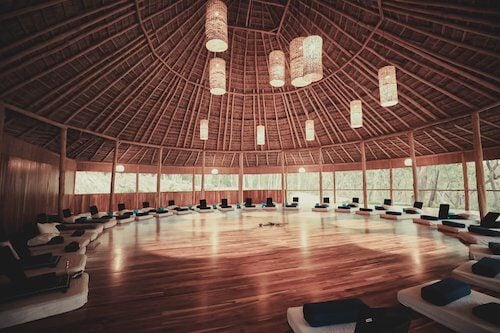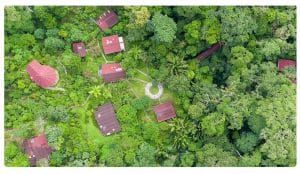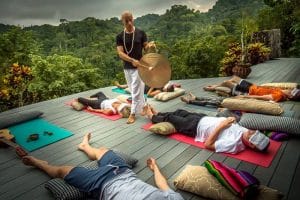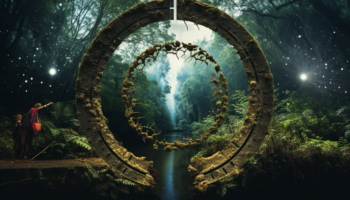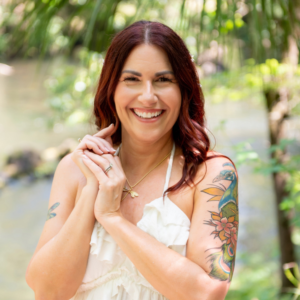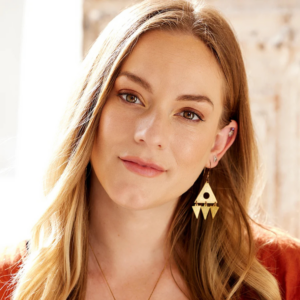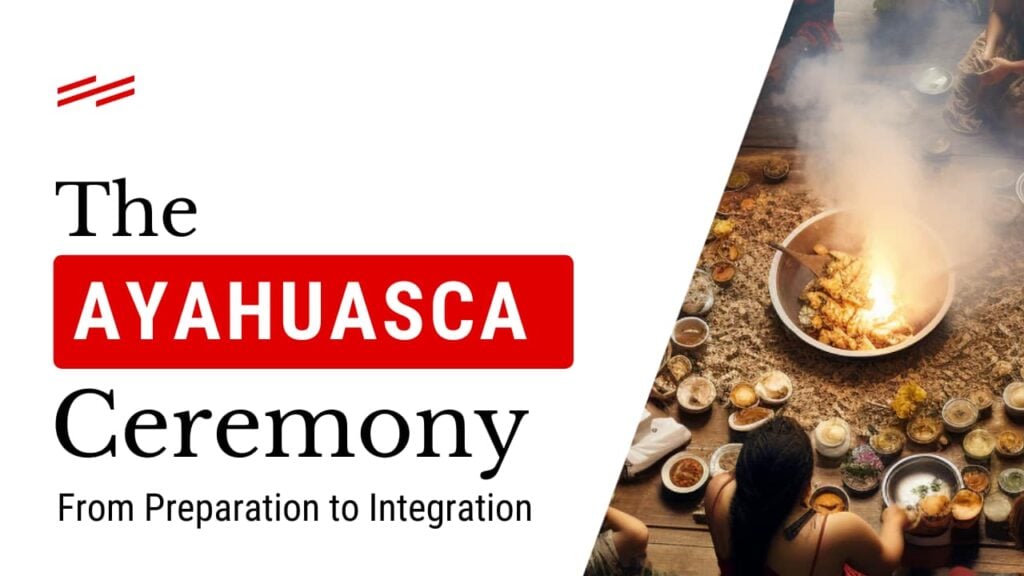
Photo credit: reunionexperience.org

Welcome to the first installment in our series on Ayahuasca retreats, sponsored by the transformational retreat organization 1Heart Journeys, an official partner of Third Wave.
Disclaimer: Ayahuasca is a largely illegal substance, and we do not encourage or condone its use where it is against the law. However, we accept that illicit drug use occurs and believe that offering responsible harm reduction information is imperative to keeping people safe. For that reason, this document is designed to enhance the safety of those who decide to use these substances.
Plant medicine journeys in legal retreat centers are becoming increasingly popular alternative-healing modalities. For many, attending an ayahuasca ceremony, in particular, have unleashed profoundly ineffable experiences difficult to put into words.
Ayahuasca’s healing capacity has countless people excited and curious to explore the plant’s therapeutic and personal-development benefits. However, many are hesitant to participate because of common effects like purging, the uncertainty of what to expect in a ceremony, or how to choose a safe ayahuasca ceremony or retreat space.
If you’re curious about ayahuasca but unsure whether an ayahuasca ceremony is right for you, this guide will help you better understand the ayahuasca experience, what to expect in an ayahuasca ceremony, and tips on choosing a safe and suitable retreat.
What Is Ayahuasca?
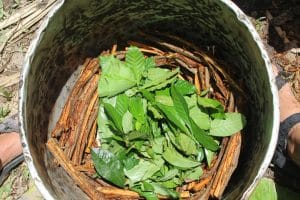
Ayahuasca is a psychedelic brew that has played a central role in South American healing and spiritual practices for hundreds of years.
The brew is typically made by boiling the Banisteriopsis caapi vine, which contains monoamine oxidase inhibitors (MAOIs), and the Psychotria viridis shrub, a source of dimethyltryptamine (DMT),
When combined, the action of these psychoactive ingredients gives rise to an altered-state experience. SinceMAOIs prevent the body naturally breaking down DMT, the experience typically lasts around seven hours, compared to a short, 20 minute experience of inhaled pure DMT.
In many traditional ayahuasca practices, healers, curanderos or curanderas, use the medicine to cross between the physical and spiritual realms, gaining and sharing sacred healing knowledge to pass on to those in need.
However, in ayahuasca ceremonies today, you will likely be drinking the medicine yourself, with the curandero or ceremony guide present to aid your personal healing journey.
What to Expect During an Ayahuasca Experience
Knowing how ayahuasca will affect you is difficult since each journey is unique and can differ from one ceremony to the next.
Because of the energetic nature of this type of healing, many of the factors influencing your ayahuasca experience are hard to grasp. Yet, as with all psychedelic experiences, it’s clear that set and setting, your emotional landscape and physical environment, play an essential role.
Other determining factors could include:
- Your physical state. For example, if you’re feeling physically exhausted, working through psychological material that arises during your trip may be more challenging.
- Any expectations or preconceived ideas you might have about the medicine or ceremony.
- Whether you’re working with any specific traumas, physical or psychological.
- Your personal relationship to trust and control, as this may determine how well you’re able to fully surrender to the experience.
In spite of these variations, ayahuasca journeys share overlapping characteristics, like duration, preparation, overall effects, and potential benefits.
How Long Does Ayahuasca Last?
Generally speaking, ayahuasca’s effects take between half an hour to two hours to kick in and last between four to six hours.
However, these timings aren’t set in stone and can vary depending on several factors, including:
- Your baseline sensitivity to psychedelic substances
- Your metabolic rate
- Whether or not it’s your first time engaging with the medicine
- Whether or not you currently take, or have a history of using medications (such as antidepressants and insulin)
- How seriously you’ve taken the dieta
What Does Ayahuasca Taste Like?

Ayahuasca can taste different depending on how it’s brewed. Some people think ayahuasca is absolutely disgusting, and others compare it to nectar from the Gods.
Commonly reported taste descriptors include:
- Earthy
- Salty
- Bitter
- Similar to prune juice
- Coffee-flavored
Since the taste can often be bitter for people, some medicine practitioners may provide you with a small piece of banana to eat after your dose. Not only does banana help coat the taste, but it may also activate the medicine even more after the experience. To help mask the taste, you could also try washing ayahuasca down with clean organic coconut water.
Finally, it’s important to remember, that although you may feel put off by the taste of ayahuasca, just remember the experience of drinking it will only last seconds compared to the medicine’s impact, which could potentially last years.
What Are the Effects of Ayahuasca?
Sensory changes
During an ayahuasca journey, you may experience visual hallucinations, ranging from mild kaleidoscopic patterns, like LSD and psilocybin, to entire dream-like scenarios. However, it’s important to not get too focused on what the visions mean directly, but rather what feelings emerge from them.
You will also probably become more sensitive to sound, light, and touch, and may feel a physical heaviness in your body.
Another common sensory effect of ayahuasca is time distortion, in which hours seem to go much slower or faster than usual. In some instances, the concept of time could disappear entirely.
Mystical experiences
Some people report ayahuasca-induced mystical experiences characterized by a loss of ego, feelings of oneness or merging with ultimate reality, and connection to a divine source.
Although the idea of mystical experiences can sound scary, they are often deeply meaningful and can bring about a newfound sense of spirituality or appreciation for the wonders of life.
Researchers have even found a link between mystical experiences and mental health benefits from psychedelics.
Encountering the ayahuasca spirit
During your ayahuasca experience, it’s possible you may encounter the ayahuasca spirit.
The concept of “plant spirit,” a life-force intelligence present in plants, is a core shamanistic belief. However, the way in which these spirits appear to people during their experiences using plant medicines is highly subjective. Some people describe the spirit as an essence of themselves, others as a full-bodied spiritual being – often encompassing serpentine-like imagery – with which they’re able to communicate.
Because of ayahuasca’s nurturing and loving traits, many people, especially in the West, associate ayahuasca with a feminine spirit, such as the Mother or Grandmother Medicine.
However, feminine titles aren’t the case across all ayahuasca-using traditions. For example, within the Peruvian Shipibo tradition, ayahuasca is called Oni (meaning wisdom) and holds both masculine and feminine energies. In the Colombian Amazon, ayahuasca is called yage and is considered to be masculine, coming from a grandfather lineage.
Purging
Not everybody purges during an ayahuasca ceremony, but for many, nausea, vomiting, crying, shaking, drastic temperature swings, laughing, and diarrhea are common.
The notion of purging seems off-putting at first. However, while western cultures may view purging as “getting sick”, for shamanic traditions across the globe, purging is part of “getting well.”
In practice, the la purga, or what ayahuasca using traditions refer to as “the purge”, is an essential part of the medicine’s healing process, as it helps remove stuck energies, toxins and traumas from the body. The physical expulsion from purging can also provide a huge felt sense of release.
In 1heart’s Awakened Leader podcast, Third Wave Founder Paul F. Austin said, “With Aya specifically, I would say don’t let the idea of purging be a block… I’ve worked with Ayahuasca about 15 times now. I didn’t purge at all until my eighth or ninth Ayahuasca experience, and now every time I go in, it’s actually what I look most forward to because there is such a deep emotional release and psychosomatic release from that experience…”
Surfacing of trauma
During your experience, ayahuasca can bring difficult emotions and challenges to the surface. However, by facing your shadows and understanding how they’re impacting your life today, you can experience deep healing.
As such, ayahuasca guides generally advise you to surrender to rather than avoid any challenging material.
“We know about ego dissolution, we know about the mystical experience, but what [psychedelics] do time and time again is they allow us to accept what is and surrender into that. And whenever there’s a significant resistance, that usually means there’s an even greater reason to let go of the thing that we are attached to…” said Paul F. Austin.
For this reason, it’s also important you feel safe during an ayahuasca ceremony, as this will also allow you to feel comfortable going deeper into difficult experiences, increasing the chances for psychological material to be processed and resolved.
One analogy you can think of, when it comes to surrendering, is how differently buffaloes and cows respond to rainstorms in the wild. When cows see a storm coming, they run away, trying to avoid the rain. This, however, only leads to fear and exhaustion. In contrast, when buffaloes see the rain, they run into it, knowing their discomfort will only be momentary, before they reach the other side of the storm.
Likewise, the more we step into our traumas during ayahuasca ceremonies, the sooner we will arrive at the other side, basking in this medicine’s gifts.
Benefits of Ayahuasca

Despite the long history of healing use, it’s only within the past decade that Western medicine has begun to explore ayahuasca’s therapeutic potential. Formal research has found the medicine can reduce symptoms of psychological disorders, including:
Outside of therapy, ayahuasca can have a multitude of benefits to enhance day-to-day life. For example:
- Increasing creativity
- Improving problem-solving
- Developing emotional empathy
- Increasing satisfaction with life
Certain retreat centers may tailor the experience to enhance the likelihood of one or more of these benefits. For example, 1heart offers carefully designed ayahuasca retreats to help entrepreneurs and creators drive innovation in light of the medicine’s creative and problem-solving enhancing capacities.
You can learn more by checking out 1heart’s participant ayahuasca-experience stories.
What Is An Ayahuasca Ceremony?
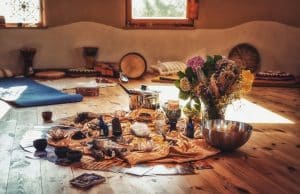
An ayahuasca ceremony is a tradition that involves drinking the medicine brew under the guidance of a facilitator or shaman for healing, spiritual, and transformation purposes.
When it comes to healing and transformation, the ceremonial setting itself can be as important as the ayahuasca plant’s psychoactive effects.
Highlighting this point, a recent double-blind study compared people who took ayahuasca to a placebo group who attended the psychedelic ceremony but didn’t drink the brew. The study found the plant helped people in the ayahuasca group develop more emotional empathy than the placebo group. But interestingly, both cohorts experienced comparable depression, anxiety, and stress relief, signifying the critical role of setting in plant-medicine healing.
On the other hand, being in a ceremony where you feel unsupported or uncomfortable can negatively shape your experience, potentially leading to negative trips and a psychedelic crisis, otherwise known as a ‘bad trip.”
As such, it’s essential to be diligent when choosing and preparing for an ayahuasca ceremony.
Preparing For An Ayahuasca Ceremony
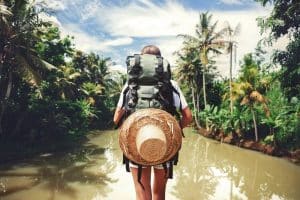
Preparing for your ayahuasca ceremony is critical to the outcome. Essential steps include:
- Research: Have an idea of what to expect during your ceremony, including who your guide(s) will be and their level of experience and reputation.
- Intention Setting: Think carefully about what you’d like to heal or change in your life and what outcomes you’re striving toward.
- Diet: Research and follow the ayahuasca diet in the weeks leading up to the journey.
- Packing: Prepare for the experience with essential retreat items. Having personal items with you to help support you during your ceremony is recommended.
Intention-setting
When intention-setting, some ayahuasca retreat and ceremony centers may help you with this process by providing exercises, practices, and advice.
For example, at 1heart, participants are offered an exercise called The Seven, consisting of seven prompts to help recognize your fears and self-limiting beliefs while realizing your passions, visions, and values.
You can also find a list of different books, podcasts and videos that could help surface up ideas around your intentions by checking out 1heart’s Expansive Guide to Ayahuasca Preparation.
The Diet
In the lead-up to an ayahuasca ceremony, you will also be instructed to follow a dieta or diet, which will vary depending on how strict the center’s guidelines are and how traditional the center is.
The purpose of the diet is to purify your body and mind in preparation for ayahuasca. It involves avoiding certain foods, such as caffeine, excess sugar, salt, and red meat. Other activities to avoid include sex, using other psychoactive substances, along with engaging with social media or current news.
“Cutting these things out, even just temporarily, signals to yourself and the medicine that you’re serious about this work. You’re respecting the process, removing what doesn’t serve you, and inviting different, healthier habits into your life,” as a 1heart alumnus shared.
Trustworthy retreat centers will also advise you to avoid anything that increases serotonin, such as antidepressant medications and fermented foods. This is medically necessary since ayahuasca also activates the neurotransmitter serotonin in the body, which can be dangerous if levels become too high.
You can find more information about the ayahuasca diet here.
The Ayahuasca Ceremony Space
Guides
In traditional-style ceremonies, the space will be held by a shaman, often accompanied by a medicine team, whose role is to create a sacred and protected area for you to feel safe to go deep into your healing experience.
Many ayahuasca retreat centers also offer guides, often called “angel facilitators,” whose job is to tend to your practical physical needs, for example, changing your sick bucket or guiding you to a toilet.
Altar
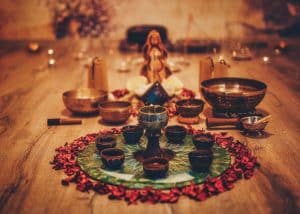
Typically, the medicine will be placed on an altar in the center of the space, alongside other sacred objects and tools for cleansing, such as the ayahuasca vine itself. It’s from the altar you will be expected to drink the medicine.
At the altar, you may also expect to find other healing medicines that can help you on your journey, such as rapé and sananga.
You may also be encouraged to bring personally significant items to create your own sacred altar.
During the Ayahuasca Ceremony
Cleansing
Before and during the ceremony, the shaman will typically perform cleansing rituals known as limpias. For example, they may shake a chakapa, a bundle of leaves typically belonging to the Pariana plant, to remove negative spiritual energies.
Prayers

The shaman will also call in different spiritual energies and share prayers with plants, animals, ancestors, and their teachers. These blessings may sometimes involve mapacho (sacred tobacco). You will likely also be asked to give your prayers outwardly to the group or as part of an internal reflection.
Sacred silence
During the ceremony, you will be encouraged to remain silent and not engage with other participants. This will allow you and others to go deep into your healing journey without distractions.
Receiving More Medicine
Around two hours into the ceremony, a second round of formal medicine often serves those who feel called.
After your first dose, you may feel a calling for more medicine. For many, it’s obvious whether or not a second cup feels necessary to take you where you’d like to go. However, before going for more cups, make sure you tune inwards and ask yourself if it’s really what you need, as shamans often advise that each cup can bring about a completely different journey. If you’re unsure, consult with the shaman, guides, or even the medicine itself.
Ayahuasca Ceremony Closing

About seven hours into the ceremony, the shaman will perform closing prayers and songs as participants end their journeying.
At this point, you may be offered food in line with the ayahuasca diet and the chance to chat with other participants before going to sleep.
These moments of connection with other participants, before and after ceremonies, can play an important part in creating positive experiences.
“The beauty is that deep connection and community can form in an instant when we are all free to shed the stories we are so busy trying to convince the world of,” described Brandon Evans, the Chief Elevation Officer of 1heart.
“… Every group leaves with people they feel closer to than many lifelong friends and even family. And the love and support that ensues when these connections are made is truly medicine.”
Although you may be excited to share your experience during this post-ceremony connection time with others, it’s encouraged to suspend sharing any quick interpretations as doing so may limit what the medicine was fully communicating with you.
It’s possible that you may still be journeying at the point the ceremony formally closes. However, in well-guided ceremonies, the facilitators will ensure that support and space are available to support you in continuing your healing.
Icaros: Music as Medicine
Music can profoundly affect psychedelic experiences, bringing up and intensifying emotions, and revelations. By following the memories and feelings instigated through music and sounds during your ceremony, you may experience key answers to help unravel your intentions.
In traditional Shipibo-style ceremonies, you can expect the shaman to perform icaros – translating to”‘language of the plants” – which are sacred, healing songs passed down through lineages of healers.
These songs contain improvised elements that call in different spirits, depending on what’s needed at different ceremony points. Typically, the shaman accompanies icaros with the rattling sound of the chakapa.
In modern ceremonies today, you may hear a more diverse range of music, expanding beyond only listening to icaros, which can include acoustic instruments, such as hang drums and guitars.
Music with lyrics tends to focus on blessings and nature, often featuring Spanish or Quechua words to pay homage to the medicine’s indigenous roots.
What to Do After Your Ayahuasca Ceremony
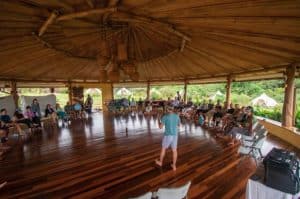
While on-site at a retreat center, you must rest and nourish yourself with healthy food in the days following your ceremony.
Retreat centers also tend to offer contemplative and embodied practices, such as meditation and yoga during the days following ceremonies, to help you mentally and physically process your experiences.
Once you leave the retreat center, it’s important to rest, eat well, and engage in healthy practices to continue your healing. If possible, try to take a few days or a week to re-acclimate before throwing yourself back into day-to-day responsibilities, such as work.
Ayahuasca Integration
Ayahuasca integration involves reflecting on your psychedelic experience, determining what lessons have been revealed, and making changes to your life accordingly. With all psychedelic journeys, it’s through this process that the sustained, transformative power of your experience can unfold.
Since integration is so critical, many retreat centers will provide you with post-retreat support. For example, 1heart offers a comprehensive virtual five-week psychedelic integration program with the whole group for accountability and support, so you can continue your path to transformation once you’ve landed outside the retreat.
How to Choose an Ayahuasca Ceremony

With more and more ayahausca ceremony and retreat centers cropping up globally, deciding which is best for you can be challenging.
Furthermore, the industry is largely unregulated, and bad actors exist who could take advantage of their power in your vulnerable state. That’s why finding a trustworthy facilitator to support and provide a safe container is critical.
Here we offer tips to help you choose a suitable and secure ayahuasca ceremony.
Ask yourself the following questions::
- Does the center fully support you in your preparation for the ceremony?
- Does the center offer a comprehensive integration program?
- What other activities are offered in the on-site retreat program?
- Does the center have a thorough screening protocol to ensure guests aren’t put in any physical or psychological danger (e.g., asking about current medication status)?
- Has the shaman and retreat center been reviewed by somebody you know personally? Or are there multiple reviews from trusted online sources?
- Are the facilitators deeply trained in the Amazon in a respected lineage?
- Do facilitators do frequent plant dietas to cleanse and invite in the spirit of the plants?
- Is there a particular type of participant the center is marketed towards, and do you feel you could find a like-minded community by attending?
- Is working one-to-one with a healer or working in a group setting going to be more conducive for your healing needs?
- Is your ceremony legally operating?
- What kind of location would you like to have your ceremony in? For example, would you like to be somewhere close to home, or would you prefer to travel? Would you prefer your ceremony be somewhere warm?
When choosing an ayahuasca ceremony, it’s also good practice to speak directly with the shaman or lead facilitator beforehand. In doing so, discussing your goals and intentions, you can determine whether you feel aligned and comfortable in their presence.
For more detailed advice, be sure to check out 1heart’s comprehensive guide on selecting an ayahuasca retreat.
Safe and Trusted Retreat Centers
To help inform your decision, here are some of the most reputable and well-trusted retreat centers operating globally.
1. 1heart: Transformational Ayahuasca Retreats for High Performing Leaders, Creators & Change-Makers
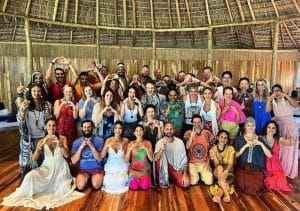
Taking place in the beautiful eco-villages in Costa Rica, 1heart’s unique immersive ayahuasca retreats are tailored for entrepreneurs, CEOs, and other creative change-makers looking to elevate their life and business.
1heart provides well-crafted retreat programs to aid in transformation, such as conscious embodiment, bio-hacking, and visioning workshops, along with a complete virtual 8-week preparation and integration program.
Participants can also expect some good old-fashioned fun and a chance to connect deeply with a mastermind group of participants with adventurous excursions and group celebrations.
Here is Paul F. Austin’s review of 1heart Journeys and why he believes it is one of the best options available for personal transformation.
2. Soltara Healing Center: Where Integration Meets Tradition
Soltara Healing Center works with indigenous Peruvian Shipibo healers and clinical psychologists to provide a uniquely integrated Western and traditional approach to healing.
With three scenic natural locations in Costa Rica and Peru, their holistic retreats include yoga, flower baths, and local excursions that range from five to twelve nights.
Working with well-qualified mental health specialists, who have a foot in both Western and traditional medicine practice, when attending a Soltra retreat, you can expect high-quality preparation and aftercare to give you the support, knowledge, and tools to best navigate and move forward from your experience.
3. Temple of the Way of Light: A Pioneering Ayahuasca Retreat Center in the Peruvian Amazon

Located in the Peruvian Amazon, the Temple of the Way of Light is a pioneering healing center in the Peruvian Amazon that has been facilitating safe ayahuasca retreats for thousands of guests since 2007.
All their retreats are guided by a team of experienced shamans, bringing in over 250 years of indigenous Shipibo knowledge and highly trained Western facilitators, who act as a critical cultural bridge and ensure participants’ mental health needs are best supported.
At the Temple, participants can expect traditional Shipibo plant-spirit healing, complemented by yoga and other practices designed to support healing work.
The Temple is also passionate about indigenous reciprocity and shares their profits with community and permaculture projects in the Amazon.
4. Lotus Vine Journeys: Ancient Medicine Meets Buddhist Wisdom
Lotus Vine Journeys represent a powerful fusion of ayahuasca tradition and Buddhist wisdom, with retreats that combine yoga, meditation, and spiritual talks with six well-curated ayahuasca ceremonies.
Their intensive 14-day experiences in the beautiful mountain jungle of Costa Rica are suited for those who prioritize helping humanity, with heart-opening being a core theme of the retreats.
Final Words
Journeying with ayahuasca can be a most transformative, life-changing event. Still, it’s important to research, prepare, and feel innately driven to the experience before experimenting with this powerful plant teacher.
In the words of Brandon Evans, the Chief Elevation Officer of 1heart:
“I have personally experienced and witnessed so much beauty occur because of this sacred plant medicine and I am in no way recommending it nor do I believe it is for everyone at this time… The medicine is very much a calling and something that each individual needs to feel into. Ultimately it is a choice if they feel ready to take on the work required to make transformational life changes.”
If you feel the calling, remember the ayahuasca ceremony setting can be just as important as the medicine itself. So make sure to carefully plan and find a center that is safe and in line with your needs and intentions.
To discover reputable, high-quality, and vetted retreat centers, such as 1heart, best suited for you, be sure to check out the Third Wave’s Psychedelic Directory.

